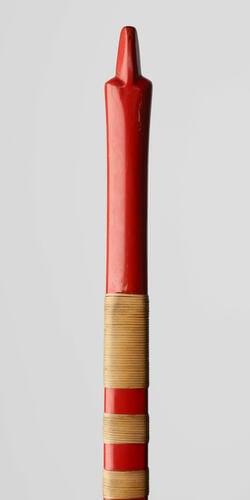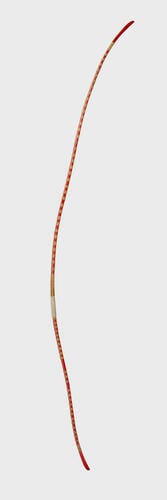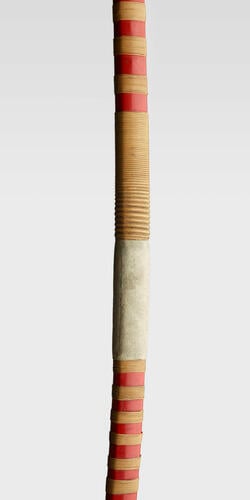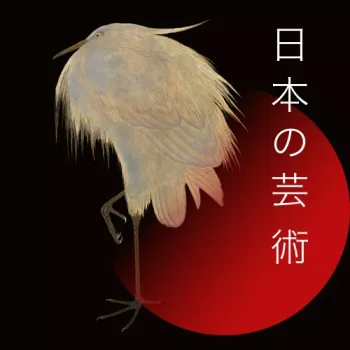Bow (yumi) 1912-22
Bamboo, rattan, lacquer, deerskin | 213.0 x 3.0 x 1.0 cm (whole object) | RCIN 79906
-
With the advent of peace in Edo-period Japan, the samurai class were instructed to maintain their warrior spirit through continued practice of archery (kyūdō) and the sword (kendō).
This Japanese bow (yumi) is over two metres long. It is of asymmetrical design, strung in a reverse curve, with the grip located one third of the way up from the bottom. There are 28 bindings below the handle and 36 above it, possibly representing the twenty-eight mansions of the Chinese constellation system and the thirty-six birds of the entire world.
The asymmetrical design enables a mounted warrior to pass the bow more easily over the horse’s head to aim and fire. However, benefits to this style of bow were apparent even before the advent of mounted warriors in Japan. Reduced handshock and a larger draw-length for the bow are also afforded by the asymmetry.
The bow is made of laminated madake bamboo and hardwood. It has been strengthend with rattan binding and coated with flexible lacquer to protect against the region's humidity - hallmarks of a high-quality shigeto-yumi.
On his final day in Japan in May 1922, Edward, Prince of Wales was entertained by Prince Shimazu Tadashige (1886–1968), son of the last feudal lord of the Satsuma domain. Lunch was served at Prince Shimazu’s villa, followed by an archery demonstration. Afterwards, the Prince of Wales was presented with a complete set for archery practice.
Text adapted from Japan: Courts and Culture (2020)Provenance
Presented to Edward VIII when Prince of Wales by the Shimadzu family following an archery demonstration at Kagoshima in May 1922. On the same occasion the Prince received a set of twelve practice arrows (RCIN 79915), a quiver (RCIN 79914), bow case (RCIN 79908), archer's glove (RCIN 79913), arm guard (now missing) and reel for spare bowstrings (now missing). (RA/EVIIIPWH/PS/VISOV/1921-2/INDJAP).
Loaned to Doncaster Museum on 11 February 1931 and returned to the Collection on 6 April 1999. -
Creator(s)
(nationality)Acquirer(s)
-
Medium and techniques
Bamboo, rattan, lacquer, deerskin
Measurements
213.0 x 3.0 x 1.0 cm (whole object)
529.8 g (Weight) (whole object)
Category
Object type(s)
Place of Production
Japan











